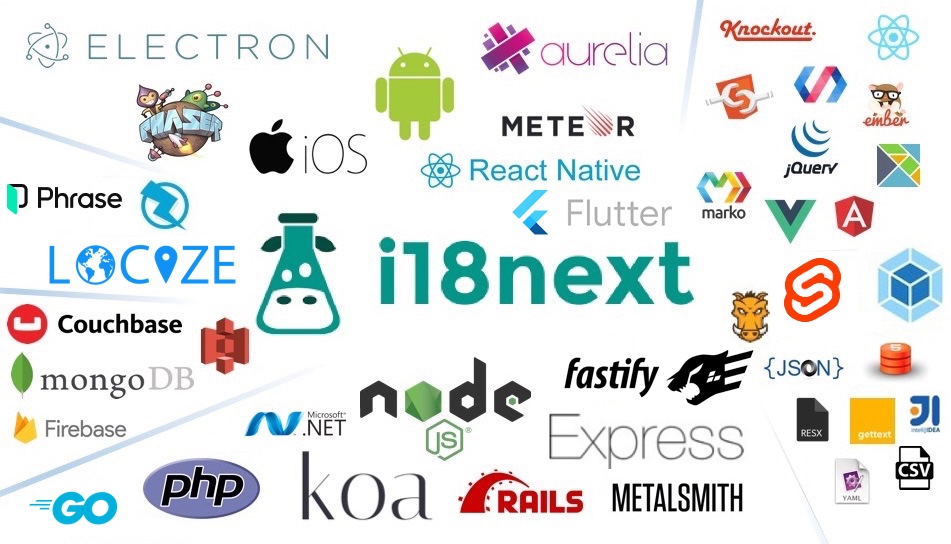Integration
- i18next:
i18next can be integrated with any JavaScript framework or library, including Angular, Vue, and vanilla JavaScript. It provides a flexible API that allows developers to customize their i18n implementation according to their needs.
- react-i18next:
react-i18next is built for React, offering hooks and components that make it easy to manage translations within React components. Its design aligns well with React's functional programming paradigm, providing a seamless experience for React developers.
- react-intl:
react-intl is also tailored for React but focuses more on formatting messages and handling internationalization. It integrates well with React's component model, allowing developers to format dates, numbers, and strings easily.
- next-i18next:
next-i18next is specifically designed for Next.js, allowing for easy integration with its routing and server-side rendering features. It simplifies the process of setting up i18n in Next.js applications, making it a preferred choice for Next.js developers.
Features
- i18next:
i18next offers a comprehensive set of features including support for multiple backends (e.g., JSON, database), interpolation, pluralization, and context-based translations. It also supports language detection and fallback, making it suitable for complex localization scenarios.
- react-i18next:
react-i18next provides React-specific features such as hooks (e.g., useTranslation) and higher-order components (e.g., withTranslation) that simplify the process of accessing translations within components. It also supports lazy loading of translations for better performance.
- react-intl:
react-intl focuses on providing rich formatting capabilities for internationalized messages, including support for pluralization, date and time formatting, and number formatting. This makes it particularly useful for applications that require precise localization.
- next-i18next:
next-i18next inherits all features of i18next while adding Next.js-specific functionalities like automatic language detection and server-side rendering support. This makes it easier to manage translations in a Next.js environment without additional configuration.
Learning Curve
- i18next:
i18next has a moderate learning curve due to its extensive features and flexibility. Developers may need to invest time in understanding its API and configuration options, especially when integrating with various frameworks.
- react-i18next:
react-i18next is designed to be easy to learn for React developers, especially those familiar with hooks. Its API is intuitive, making it accessible for those new to internationalization in React applications.
- react-intl:
react-intl may have a steeper learning curve for developers who are not familiar with message formatting and localization concepts. However, its clear documentation and examples help ease the learning process.
- next-i18next:
next-i18next has a relatively low learning curve for developers familiar with Next.js, as it builds on the existing Next.js structure and conventions. Its integration is straightforward, requiring minimal setup for i18n.
Community and Support
- i18next:
i18next has a large and active community, with extensive documentation and numerous plugins available. This support makes it easier for developers to find solutions and best practices for implementing i18n.
- react-i18next:
react-i18next has a strong community within the React ecosystem, with plenty of resources, tutorials, and examples available. Its popularity among React developers ensures ongoing support and updates.
- react-intl:
react-intl is part of the FormatJS project, which has a dedicated community and comprehensive documentation. Developers can find a wealth of resources and examples to help with implementation.
- next-i18next:
next-i18next benefits from the growing Next.js community, which provides support and resources for developers. Its integration with Next.js also means that developers can leverage existing Next.js resources for i18n.
Performance
- i18next:
i18next is optimized for performance, with features like lazy loading of translations and caching mechanisms to reduce load times and improve user experience. However, developers must manage the complexity of its configuration to maintain performance.
- react-i18next:
react-i18next is designed for performance in React applications, with features like lazy loading and optimized rendering to minimize unnecessary updates. Its hooks-based approach allows for efficient state management and re-rendering.
- react-intl:
react-intl focuses on performance through efficient message formatting and caching. However, developers should be mindful of the complexity of managing multiple formats and locales, which can impact performance if not handled correctly.
- next-i18next:
next-i18next leverages Next.js's built-in performance optimizations, such as server-side rendering and static site generation, to enhance the performance of i18n in applications. This makes it a great choice for performance-sensitive applications.




















